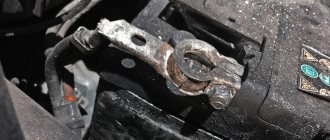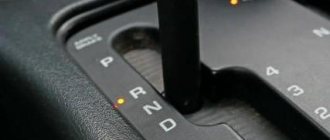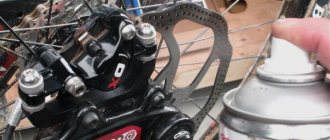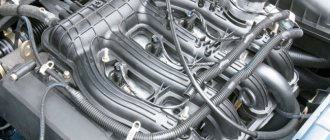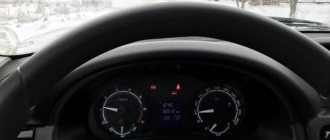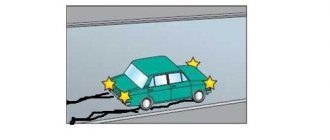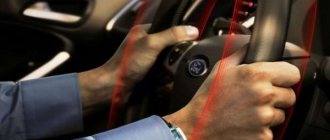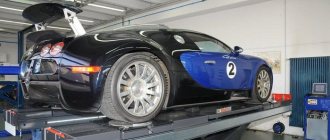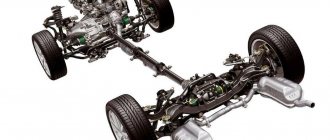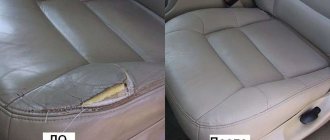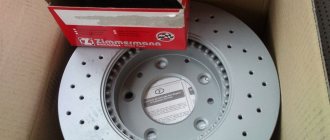The brakes are jerky - the main reasons for jerking when braking
There are a number of reasons why a car brakes jerkily . Among them are the use of new, not yet ground-in brake pads, air getting into the braking system fluid, curvature of the brake discs, partial failure of silent blocks and/or steering ends, problems with the pendulum bushings. In isolated cases, a situation is possible when the car not only brakes jerkily, but also hits the steering wheel.
It’s worth saying right away that the listed malfunctions are very dangerous and can lead not only to the failure of critical components of the car, but also to the creation of an emergency situation on the roads! Accordingly, if a situation arises when the car brakes jerkily, it is necessary to take emergency measures to identify the malfunction and eliminate it.
Causes of jerking when braking
First, let's list the most common reasons why a car brakes jerkily. So, these include:
- Airing the hydraulic brake system . This phenomenon occurs due to depressurization of the corresponding system on hoses, cylinders or in its other components. Air in the brake system reduces the efficiency of its operation, including sometimes a situation when the car brakes jerkily when braking. Often, before the appearance of jerks, there is a general decrease in the effectiveness of the braking system. Therefore, jerking is the final signal that the system needs to be pumped and brake fluid added to it.
- Curvature of brake/brake discs . This situation may arise, for example, due to their sudden cooling. In particular, after sharp braking, when the disc is very hot, the car drives into a puddle of cold water, as a result of which a sharp temperature difference occurs in the material from which the brake disc is made. If it (the material) is not of sufficient quality, then there is a possibility that the product may change its geometric shape (it may become trite). This situation is especially relevant for non-original or simply cheap low-quality discs.
Types of brake disc deformation
Remember that the thickness of the brake discs must be more than 20 mm! If this is not the case, both disks must be replaced.
There is a special device - a dial indicator, with which you can measure the degree of runout of the disc on the pad. It is available at most service stations, as well as for free sale, and is inexpensive.
- Rust on the disc . A very exotic option, relevant, in particular, for used cars from Japan. So, when the car is parked for a long time without moving, a coating of rust forms between the brake pad and the disc, which is subsequently perceived as impacts during braking. The phenomenon is especially active when the disks rotate synchronously. For reference: in the coastal conditions of Japan or Vladivostok (fog, high humidity), the discs can rust in just a couple of months, provided that the car is parked outside without moving.
- Incorrect disk installation . When replacing this unit/assemblies by inexperienced craftsmen, situations sometimes arise when the disc is installed crookedly, which causes friction against the pad. This is even if the disc is new and smooth.
- Drum curvature . Similar to the previous points. Changes in drum geometry can be caused by wear or due to sudden changes in their operating temperature.
- Worn brake pads . Some car owners note a situation where, with very worn brake pads, the car begins to brake jerkily. A whistle when braking can also confirm wear. It can be caused either by a critical level of pad wear or by the work of the so-called “squeakers” - special metal antennae that rub against the discs, causing a squeak and thereby signaling the car owner about the need to replace the brake pads. Sometimes vibration is possible when operating even new pads, often provided that they are of very poor quality.
- Rear pads sticking . This is a fairly rare situation, which sometimes occurs in the case of prolonged braking and poor-quality pads. But in this case, vibration will occur not only during braking, but also while driving.
- The front calipers are loose . More precisely, we are talking about the fact that their fingers were simply worn down during use. This situation occurs infrequently and only on cars with very high mileage.
- Inconsistency between the softness of discs and pads . This situation implies that “soft” discs (drums) and “hard” pads were installed. As a result, the pads bite into the discs (drums), thereby damaging them. Worn brake disc
- Large play in wheel bearings . In this case, when braking, the wheels will vibrate, and this will automatically cause vibration of the entire car. This is especially true for the front wheels, as they are more heavily loaded during braking.
- Damaged silent blocks . We are talking about the silent blocks of the rear suspension. With significant wear and tear, some motorists note a situation where the car begins to jerk when braking.
According to statistics, about 90% of cases when vibration occurs when driving is associated with curvature of brake discs . Accordingly, the check must begin with these nodes.
Troubleshooting Methods
Now let's move on directly to the description of repair work that can be used to fix the problem when the car brakes jerkily at low and/or high speeds. We list the methods in the same order as the reasons. So:
- Airing the system . In this case, it is necessary to pump it, remove the air and add the required amount of new brake fluid. You will find the relevant information in the material, which describes how to properly bleed the brake system of a car.
- Warped brake disc . There are two possible options here. The first is that if the thickness of the disk is large enough, then you can try to grind it on a special machine. To do this, seek help from a service station or car service center. However, not all services perform such work. You can contact a familiar turner. The second option is more rational and safe. It consists of completely replacing the disk if its deformation is significant and/or the disk is already worn out and quite thin. In this case, it is better not to take risks and make an appropriate replacement. And you need to change discs (drums) in pairs (left and right at the same time). Checking the disk yourself only makes sense if the disk is severely damaged. Therefore, it is better to carry out inspections, and even more so repairs, at a specialized service station.
- Incorrect installation of disks . To correct the situation, you must remove and install the disk/disks exactly in accordance with the instructions.
- Drum curvature . There are two ways out here. The first is to give it to a turner for boring. The second is their replacement. Depends on the degree of wear and curved geometry of the drums. But it is better to install new nodes.
- Worn pads . In this case, everything is very simple - you need to replace them with new ones. The main thing is to choose them correctly. And the replacement procedure can be performed independently (if you have experience and understanding of such work) or in a car service center.
- Pad sticking . It is necessary to carry out repair work on the lift to restore the functionality of the pads and calipers. It is best to replace the used pads with new, good quality ones to prevent similar situations from occurring in the future.
- The calipers are loose . Repair in this case is impossible. It is necessary to replace the calipers, pins, and, if necessary, pads. When reassembling all components, do not forget to lubricate everything thoroughly with caliper and guide grease.
- Inconsistency between the softness of discs and pads . When choosing these and other nodes, you need to pay attention to the corresponding stiffness value. If necessary, replace some or other parts.
- Large play in wheel bearings . Here, most likely, you will have to replace the corresponding components. You can try to repair them, however, as practice shows, such an idea is ineffective.
- Rust on the brake disc . If the rust deposit is small, then you can do nothing, but operate the car for 500...1000 kilometers until the rust is naturally removed under the influence of the brake pads. Another option is to groove the discs. In fact, the second option is preferable, but more expensive.
- Damaged silent blocks . It is necessary to inspect the mentioned components and, if necessary, replace them.
Jerking when braking a car - looking for and eliminating the causes
Among the malfunctions of the car's chassis, the phenomenon of noticeable jerking when braking is quite common. They are especially obvious when the driver presses the brake pedal while descending a hill. This breakdown, in addition to causing inconvenience to the driver while driving, indicates a malfunction in the braking system, and, as you know, it is not to be trifled with.
1 Jerks when braking - causes and primary diagnosis
There may be several reasons for this behavior of a car; in order to accurately determine a specific one, you need to “listen” to the car in different driving modes and the use of the braking system. We list the most likely of them:
- Deformation of brake discs or drums.
- Poor quality brake pads or excessive wear.
- Worn or damaged wheel bearing.
- Piston jamming in the wheel brake caliper due to contamination.
- Foreign bodies entering or rust forming on the brake caliper.
- Low level of brake fluid or loss of performance characteristics as a result of operation beyond the recommended period.
The main reason why the car brakes jerkily when braking is usually a problem with the discs or drums. During intense driving, these elements tend to heat up, and their temperature can reach up to 100 degrees.
If at this moment a car wheel falls into water (a puddle, a stream), then an unfavorable outcome is quite likely - deformation or curvature of the brake disc. In common parlance it is also called “disc egg”.
Curvature entails an uneven fit of the brake pads to the surfaces and, as a result, one side will brake well, the other - worse. This is the basis for jerking at low speed.
You can check the disk for curvature yourself in the following way: you need to jack up the car on both sides of one axle so that the wheels rotate freely above the ground. Then, having previously turned on the neutral speed, spin the wheel as much as possible and very smoothly press the brake pedal. In case of disc deformation, uneven braking can be easily detected without special tools. It is better to carry out such diagnostics together.
Repairing this malfunction in a garage is impossible, so you need to go to a good service station, where they will re-groove the disc at a special stand or directly on the car. In some cases, it is more advisable to replace the disks with new ones, but you need to remember that they are replaced in pairs.
When purchasing components for a car’s brake system, you need to stick to well-known manufacturers and not be fooled by the cheap price. The load on the elements here is quite impressive and you should take care of your safety and the safety of others.
The second most common cause of jerking during braking is excessive wear of the pads, or rather, one of a pair on the wheel. Wear manifests itself in the fact that the braking friction layer wears off over time and begins to collapse under the influence of high pressure and torque of the wheel. In this case, braking may be accompanied by a grinding or creaking noise, by which this malfunction can be recognized.
In order to verify that the pads are faulty, you need to remove the front wheels, loosen the brake caliper and remove the parts from it. A visual inspection allows you to completely verify their technical condition. If the friction layer is uneven, there are grooves and potholes on it, or it is less than 4 mm, the pads must be replaced. They, just like brake discs, are replaced in pairs on both wheels. The rear wheels of the car also need to be checked.
Wheel bearing wear rarely occurs as a cause of jerking, but it is still worth diagnosing this part. To do this, you need to remove the wheel and move the brake disc in different directions with your hands. If there is play, bearing replacement is required.
But even if play is not detected, you need to carefully inspect the hub for foreign lubricants that can be squeezed out of the bearing, if possible, tap the hub with a wooden hammer and try to notice its movement on the bearing.
If there is the slightest suspicion that this unit is faulty, you need to contact a car service, since replacing the bearing yourself is problematic.
2 Brake caliper - possible cause of malfunction
The brake caliper is a mechanism that serves to hold the brake pads in their normal place and press them against the brake disc, as a result of which braking occurs. In its design, it has a hydraulic piston that comes out when the brake pedal is pressed. The piston transmits force directly to the pad.
When operating a vehicle in aggressive environments, off-road, a situation may occur when the rubber boot that protects the piston from foreign bodies and liquids is damaged, and dirt penetrates into the sliding mechanism of the piston. In this case, the piston jams, that is, it does not come out or does not go in completely.
In addition, one side may stick out more than the other, causing the brake pad to adhere unevenly to the disc on one side.
As a rule, this breakdown is accompanied not only by jerking when braking, but also by a beating in the brake pedal when pressed hard, as well as vibration of the steering wheel. Therefore, it is quite easy to identify this particular malfunction.
To repair the piston, if you want to do it yourself, you need to dismantle the wheel, unscrew the caliper, after first disconnecting the brake hose and ABS cable (if equipped). After this, remove the boot and seals holding the piston and rinse everything thoroughly.
Reassemble in the reverse order, replacing the seals and boot with new ones. After the procedure, you need to bleed the brakes. Usually, flushing the piston system allows you to get rid of the unpleasant effect.
During operation, it is also necessary to regularly monitor the brake fluid level and change it once every 3 years. Its leakage or low level can often cause jerking when braking.
: Jerking when braking a car - looking for and eliminating the causes
Source: https://autoexpert.today/tyuning/ryvki-pri-tormozhenii-avtomobilya-ishhem-i-ustranyaem-prichiny.html
Brake pads
First of all, you should pay attention to the wear of parts: this can be determined by the whistle that occurs when braking. In some car models, special metal “whiskers” are installed that rub against the discs when the pads wear excessively, resulting in an unpleasant sound. To check the condition of the pads, remove the wheel and check the required thickness of the friction linings: it should be at least four millimeters. If this is not the case, the parts need to be replaced. This must also be done if the friction linings have cracks, potholes and other defects. The second point is low-quality parts. If the brake pads are not up to standard, jerky braking is inevitable. And another (rather rare) reason for this malfunction is sticking of the rear pads. This can be understood by the vibration that occurs not only during braking, but also during movement. In any case, the pads must be replaced with new or better ones. You can do this yourself (provided you have certain skills and tools) or contact a car service.
Read also: Human addiction to the phone
Why does the steering wheel shake when braking and how to fix it?
Vibration of various elements of the car inevitably occurs during operation, when the moving parts of the chassis and transmission gradually wear out. But among such malfunctions, there is one dangerous malfunction - the steering wheel wobbles when braking. The more the steering wheel jerks after pressing the brake pedal sharply, the higher the likelihood of losing control and flying off the road at a decent speed. To avoid the described emergency situation, it is worth studying the nature of the problem and how to solve it.
Other causes of vibration
Steering wheel vibrations that are not associated with the car jerking in different directions appear for the following reasons:
- One of the vehicle's process fluids, for example, transmission oil, got on the pads as a result of oil seal wear. Possessing significant viscosity, the lubricant adheres well to any surface and disrupts the normal operation of the brakes when the pedal is pressed sharply.
- The internal elements of the steering rack have worn out, and significant play has appeared.
- The steering rod ball pins have become unusable.
- Inoperability of shock absorbers and front struts. Vibration on the steering wheel is felt when braking sharply and at the same time entering a turn.
Note. Problems associated with wear of ball joints and shock absorbers also appear on the wheels of the rear axle. Most often, brake fluid gets on the pads, the reasons are faulty working cylinders and leaky rubber cuffs.
A strong side impact of any wheel on a high curb (for example, due to ice or an accident) can lead to deformation and subsequent vibration. The main load is taken by the disk, wheel bearing and various suspension joints. Any of the listed parts can become cracked and cause the steering wheel to vibrate during braking.
When braking, the car brakes jerkily
There are a number of reasons why a car brakes jerkily . Among them are the use of new, not yet ground-in brake pads, air getting into the braking system fluid, curvature of the brake discs, partial failure of silent blocks and/or steering ends, problems with the pendulum bushings. In isolated cases, a situation is possible when the car not only brakes jerkily, but also hits the steering wheel.
It’s worth saying right away that the listed malfunctions are very dangerous and can lead not only to the failure of critical components of the car, but also to the creation of an emergency situation on the roads! Accordingly, if a situation arises when the car brakes jerkily, it is necessary to take emergency measures to identify the malfunction and eliminate it.
Where does steering wheel wobble come from?
Steering wheel beating at the moment of braking means spontaneous jerking of the steering wheel in different directions. In especially advanced cases, the vibration is so strong that the driver has to literally catch the car on the road. At speeds above 50 km/h, the phenomenon creates a real danger for vehicle passengers.
Since the steering wheel is rigidly connected to the front wheel hubs through a rack and ball ends, the source of the problem must be sought in the chassis and braking system of the car. The main causes of strong vibration lie in various defects of the brake disc:
- the working part of the product is deformed and has a wavy surface;
- due to the impact, the disk was damaged and cracked;
- The spare part was originally defective or installed incorrectly.
It is no coincidence that the front brake discs are named as the culprits. As soon as the working surface of the part changes its shape a little or gets a defect, after the pads are activated, the front wheels will begin to wobble, repeating the rotation of the uneven element. The steering wheel hits even harder when braking at high speed, as the speed of the front wheels increases.
How a wave-like deformation appears on a disk:
- As the car moves, the elements are repeatedly captured by the pads and can become very hot.
- The temperature is distributed unevenly over the surface; accordingly, the metal in different parts of the part expands more or less.
- If, at the moment of maximum heating, the wheel falls into a puddle or snow, the metal cools sharply and retains its concave shape.
- The brake pads grip the disc and force the wheel to follow the path of rotation of the deformed surface. This is why the steering wheel shakes when braking.
Steering wheel runout also appears after the element is incorrectly fastened or in the presence of a manufacturing defect, when the surface of the spare part is initially curved.
The car jerks when you press the brake
No matter how reliable a modern car is, sooner or later there comes a time when a friend on wheels suddenly starts knocking, twitching, and smoking. Naturally, such symptoms need to be treated urgently. But how to treat and with what?
Listening to the car Of course, the right option would be to go to the hospital (to a service station) for diagnosis and treatment, but the services of modern doctors (car mechanics) cost some money. Therefore, bending to the realities of modern life, many car owners have to independently master the basics of diagnosing and treating their own car.
The operation of a serviceable car should not cause alarm, much less discomfort. Even a slight deviation from the norm is evidence that some components or assemblies are losing ground. The reaction must be immediate, since the consequence of one breakdown is another breakdown.
The movement is jerky, the car jerks when braking - possible malfunctions
A very common behavior of a car is jerky movement, which is clearly visible during acceleration, and when braking the car even jerks.
.
The reason for this behavior of a car with a gasoline engine and an injection system may be a breakdown of the injector
.
Correct diagnosis is the key to successful treatment
Jerking when driving Putting injector malfunction in the first place in provoking jerking and jerking, it is important to note that in practice there are other causes
of car malfunctions with similar symptoms.
For example, it happens that the engine has three bypass channels. Moreover, one with an electric IAC, the other with a mechanical IAC, the third is completely equipped with an adjustment screw. The car jerks when braking
, jerking can be observed, but with a slow decrease in speed these symptoms are not observed.
The reason may lie in the mechanical temperature KDV and in the air lock of the cooling system
. A small air lock in the KDV led to partial washing of the bimetallic element and, as a result of its heating/cooling, air was supplied to the cylinders in parts, which was reflected on the wheels.
Reasons why a car brakes jerkily
There are several explanations for this unpleasant phenomenon: the installation of new, not yet worn-in brake pads, curvature of the brake discs, air getting into the brake system, wear of the silent blocks or pendulum bushings. In all such situations, the car brakes jerkily, and sometimes also hits the steering wheel. The above problems are very dangerous and can lead to breakdown of important components of the car, which can create a dangerous situation when driving.
What can happen if the car brakes jerkily when braking?
If the movement occurs on a slippery surface, the car may skew to one side: as a result, the car moves out of its lane. You will still be “lucky” if, after skidding, the car ends up on the side of the road or crashes into a snowdrift. It will be much worse if the vehicle drifts into the oncoming lane.
What else is fraught with the situation when the car brakes jerkily? This is an increase in braking distance and an unpredictable change in the trajectory of movement when braking. All this can lead to a collision. Below are the main elements of the car that cause jerking when braking.
Brake pads
First of all, you should pay attention to the wear of parts: this can be determined by the whistle that occurs when braking. In some car models, special metal “whiskers” are installed that rub against the discs when the pads wear excessively, resulting in an unpleasant sound.
To check the condition of the pads, remove the wheel and check the required thickness of the friction linings: it should be at least four millimeters. If this is not the case, the parts need to be replaced.
This must also be done if the friction linings have cracks, potholes and other defects.
The second point is low-quality parts. If the brake pads are not up to standard, jerky braking is inevitable. And another (rather rare) reason for this malfunction is sticking of the rear pads. This can be understood by the vibration that occurs not only during braking, but also during movement. In any case, the pads must be replaced with new or better ones. You can do this yourself (provided you have certain skills and tools) or contact a car service.
Brake discs
If you had them installed recently, then one of the likely reasons for the car braking jerkily is unprofessional repairs. Discs are installed in strict accordance with the instructions for a specific car brand. Also pay attention to the condition of this spare part: if it is bent (perhaps you bought a defective one), you will have to contact the nearest service station.
There your disc will be sharpened if its thickness allows this; otherwise you will have to buy a new one. Along the way, it is worth noting that the operation of brake discs (and drums) is associated with strong heating, up to 100 degrees. If at this moment the wheel gets into a puddle, the probability of curvature occurring is very high (in 90% of cases, jerks during braking are associated precisely with the curvature of the discs).
You can check this part for bending yourself:
- To do this, you need to jack up the car on both sides along one axis: both rear wheels or two front wheels.
- Next, you will need an assistant: you spin the wheels one by one with your hand, and he smoothly squeezes the brake pedal.
- The beat will be visible immediately. A small nuance: if you decide to change the brake disc, it is recommended to do this simultaneously on two pairs of wheels (left and right). If the car has been parked for a long time, corrosion of the disc is possible: then simply sand it with fine sandpaper or drive 500-1000 km.
Calipers and bearings
Worn-out calipers are a sad matter: there is only one option: replacement. The same can be said about wheel bearings: the most reliable option to eliminate their play is to purchase and install new elements. But it’s still worth checking them first.
Place the car on a jack, remove the wheel and rock the brake disc in different directions. If no play is detected, there is no need to calm down: inspect the bearing, make sure that it has lubricant. If there is even a slight suspicion of a defect, contact the nearest car service: replacing parts requires the use of special devices: pullers, etc., as well as experience.
Silent blocks
This refers to the parts on the rear suspension. If the silent blocks are heavily worn, the car jerks when braking (especially if you press the pedal sharply). The problem is solved by replacing parts.
How to brake correctly with manual brakes
We can talk about safe driving if the driver at any moment of movement has the opportunity to make a maneuver to avoid a collision. There are three main ways to perform such maneuvers:
- Changing the direction of movement (via the steering mechanism).
- Braking:
- with activation of the braking system (by pressing the brake pedal);
- engine (by releasing the gas pedal).
- Acceleration (increasing fuel supply by pressing the gas pedal).
Provided the tires have good adhesion to the road surface and the car is in good condition, stopping it by pressing the brake pedal or changing direction is not difficult. But maneuvering with the engine is not so easy. We will tell you how to properly brake with a manual engine. You can accelerate or brake by adjusting the pressure on the gas pedal if the following conditions are met:
- the transmission is in the on state;
- The gear must be engaged in the one in which the engine has a reserve of thrust.
The first condition assumes that the vehicle is not coasting at the moment of the maneuver, that is, the clutch is not depressed and neutral gear is not engaged. If you are coasting, you will not be able to control the car using the gas pedal.
The conclusion from this is this: proper manual braking means braking in gear until the car comes to a complete stop. You should forget about coasting.
Let's remember why you press the clutch pedal when you start braking? To prevent engine stalling. What could lead to it? Low speed (below idle). As a rule, idle speed is 800 rpm according to the tachometer. The engine does not stall when the speed is reduced to 500 rpm. If the frequency is less than 500 rpm, the motor turns off. And at a frequency of 1500, 2000, 3000 rpm it will work.
Therefore, if the gear is engaged, do not be afraid and start engine braking, not forgetting to periodically glance at the tachometer. Pay close attention to the road and monitor the situation behind you in the rearview mirror (to react in a timely manner if the car behind you does not have time to brake). Monitor the tachometer readings and depress the clutch pedal as the speed drops to 1000 rpm.
Some people think that depressing the clutch pedal or shifting into neutral when braking is necessary to save fuel. However, it is not. The design of modern cars is such that when braking in a gear, no fuel is supplied to the engine at all, but when coasting, the engine’s fuel consumption is 1-2 liters per hour.
Do not forget: neutral gear is a technological necessity, its function is to ensure the ability to change gears and operate the engine when the car is stopped. But driving in neutral is absolutely forbidden! The same applies to the clutch pedal. It allows you to start smoothly, change gears and prevent the engine from stalling when stopping. And you don’t need to squeeze it while moving. Accordingly, the question of how to brake with a manual transmission with a clutch is irrelevant.
The engine needs a reserve of thrust. Therefore, not just any gear should be engaged, but one that provides maximum torque and engine thrust reserve. That is, when you brake, the revolutions should be at least 2500 per minute (except for 1st and 2nd gears), if the car is equipped with a standard naturally aspirated gasoline engine. If the engine is a supercharged gasoline engine, then the speed can be kept at about 2000 per minute. With a diesel engine, you can brake at a speed of 1500 rpm.
How to fulfill these requirements in practice and brake correctly with manual brakes? Simply braking in gear is not enough; downshifts are required as the car slows down to maintain engine speed.
The tachometer scale is divided into two zones: economical and high-speed. The boundary of these zones for an atmospheric gasoline engine is 3000–3500 rpm. This means that during normal acceleration, upshifting should be done when the engine reaches these speeds. If you accelerate to 3000 rpm in each gear, then the movement will be smooth and calm, but if you push it to 3500 rpm, the acceleration will be more active.
But what is more important is that after changing gears at 3500 rpm, their frequency decreases to 2500 rpm, after which it increases again to 3500. That is, when accelerating, the tachometer needle walks between the values of 2500 and 3500 rpm with each increase in gear .
The engine speed should change similarly when the car is stopped. You need to monitor the tachometer readings regardless of the method of braking (engine or brake system). When the rotation speed reaches 2500 rpm, the gear must be lowered, and then the speed will increase again to 3500. In a lower gear, you also need to brake to 2500 rpm. The reduction should be carried out to 2nd gear. It is correct to brake in 2nd gear until you come to a complete stop.
It is necessary to depress the clutch pedal when the tachometer needle drops to 1000 rpm. Already with the clutch depressed, the coasting braking process starts until the car comes to a complete stop.
Now we fully expect the question: “Why such difficulties? Why can’t you brake by simply pressing the brake pedal?” Of course, this option has a right to exist. However, when driving a car, the nature of many actions and their consequences is probabilistic.
Various driving techniques can increase or decrease the likelihood of an accident. If you stop the car by simply pressing the brake pedal, then this is safe from the point of view of braking in itself, but in this case it is much more difficult to manage the situation when unforeseen circumstances arise.
Let's imagine a situation: you are driving along the road and at an intersection you need to go left. Approaching a turn, you turn on the turn signal and begin to brake. Your speed is 60 km/h, fourth gear is engaged. This is where you begin the braking process. Before slowing down, the speed was 2000 per minute, and as it stopped it began to decrease.
Of course, under no circumstances should you turn, but continue driving straight, stop braking and then accelerate. And you are still driving in fourth gear, the revolutions have dropped to 1500, that is, the engine has completely no reserve of traction (even if the engine is diesel or has a turbine). You press the gas pedal furiously, but you do not achieve acceleration. There’s simply no time to change gear, nor is there time to think about which one to turn on.
Let's change the initial conditions: when you start braking, you consistently reduce the gear as the tachometer readings decrease. Noticing a car approaching you from behind, you easily switch to the next, II, gear, the speed is 3000 per minute. You press the gas pedal, the car reacts immediately, and you accelerate away from a collision.
Let's look at another example. On the bend, you slowed down, and already starting to turn, you realized that it was still high. The grip of the tires on the road surface weakens so much that you leave the desired trajectory, cannot turn and move towards the side of the oncoming lane.
What should you do in case of demolition? There are several options. Perhaps the best way is to apply the engine brake, that is, stop pressing on the gas, thereby reducing the speed, and wait for traction to be restored. This will allow you to level the car and continue driving.
It is quite clear that if you turn while the gear is in neutral, you will not be able to straighten the vehicle in the described way, because in this case it is impossible to control the car with the gas pedal. You should not enter a turn with fifth gear engaged. At a speed of, for example, 70 km/h, the engine speed would be no more than 2000 per minute. With this value, the engine thrust is minimal, so you won’t be able to brake quickly.
It is best to corner with the tachometer reading 3000–3500 rpm. At 70 km/h for most cars this is third gear. In this case, engine braking will be as effective as possible. The car will be able to be straightened out and an accident will be avoided.
